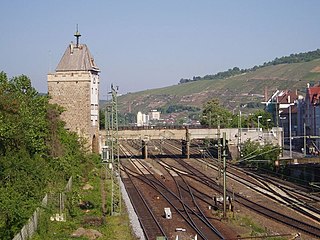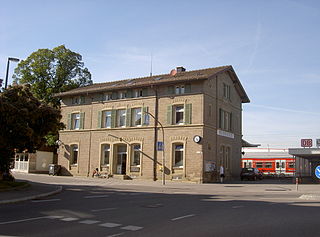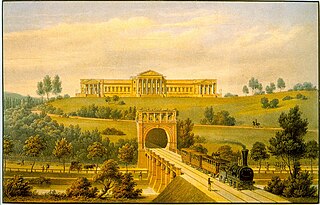
Wilhelm Maybach was an early German engine designer and industrialist. During the 1890s he was hailed in France, then the world centre for car production, as the "King of Designers".

Neckarstadion, officially known as MHPArena for sponsorship reasons, is a stadium located in Stuttgart, Baden-Württemberg, Germany, and home to Bundesliga club VfB Stuttgart. It hosted football matches in the 1974 FIFA World Cup, the UEFA Euro 1988, the 2006 FIFA World Cup, and the UEFA Euro 2024. Besides that the 1959 European Cup Final, the replay of the 1962 European Cup Winners' Cup final, the 1988 European Cup Final, and the second leg of the 1989 UEFA Cup final took place in the stadium. The stadium is the only venue in Europe to have hosted multiple World Cup, European Championship and European Cup/Champions League Final matches. The stadium hosted the 1986 European Athletics Championships and the 1993 World Athletics Championships before it was redeveloped into a football-specific stadium in 2009.

Daimler-Motoren-Gesellschaft was a German engineering company and later automobile manufacturer, in operation from 1890 until 1926. Founded by Gottlieb Daimler (1834–1900) and Wilhelm Maybach (1846–1929), it was based first in Cannstatt. Daimler died in 1900, and their business moved in 1903 to Stuttgart-Untertürkheim after the original factory was destroyed by fire, and again to Berlin in 1922. Other factories were located in Marienfelde and Sindelfingen.

The Stuttgart S-Bahn is a suburban railway system (S-Bahn) serving the Stuttgart Region, an urban agglomeration of around 2.7 million people, consisting of the city of Stuttgart and the adjacent districts of Esslingen, Böblingen, Ludwigsburg and Rems-Murr-Kreis.

Stuttgart Hauptbahnhof is the primary railway station in the city of Stuttgart, the state capital of Baden-Württemberg, in southwestern Germany. It is the largest regional and long-distance railway station in Stuttgart, the main node of the Stuttgart S-Bahn network, and, together with the station at Charlottenplatz, it is the main node of the Stuttgart Stadtbahn.

The Stuttgart Stadtbahn is a semi-metro system in Stuttgart, Germany. The Stadtbahn began service on 28 September 1985. It is operated by the Stuttgarter Straßenbahnen AG (SSB), which also operates the bus systems in that city. The Stuttgart Stadtbahn is successor system of a tram network (Straßenbahnen) that characterized the urban traffic in Stuttgart for decades.

The Fils Valley Railway designates the Württemberg line from Stuttgart via Göppingen to Ulm. It runs from Plochingen to Geislingen an der Steige through the Fils Valley.

Ulm Hauptbahnhof is the main station in the city of Ulm, which lies on the Danube, on the border of the German states of Baden-Württemberg and Bavaria in the Danube-Iller region.

The Stuttgart-Bad Cannstatt–Nördlingen railway is a main line in Baden-Württemberg and Bavaria, Germany. It branches off the Stuttgart–Ulm railway at Stuttgart-Bad Cannstatt station and runs via Aalen to Nördlingen, where it merges with the Augsburg–Nördlingen railway. Between Bad Cannstatt and Goldshöfe, the line is part of the long-distance inter-regional connection between Stuttgart and Nuremberg. The line has two tracks from Bad Cannstatt to Goldshöfe and the remaining section is single track. The line is fully electrified and the western section from Stuttgart to Schorndorf is part of the Stuttgart S-Bahn.

Bad Cannstatt station is the second largest station of the German city of Stuttgart after Stuttgart Hauptbahnhof and has eight platform tracks. Together with Untertürkheim station, it is the oldest station in Württemberg.

Esslingen (Neckar) station is the most important station in the town of Esslingen am Neckar in the German state of Baden-Württemberg and is located 13.2 kilometres (8.2 mi) from Stuttgart Hauptbahnhof on the Fils Valley Railway.

Plochingen station is the only station in the town of Plochingen in the German state of Baden-Württemberg and the most important railway junction of the Esslingen district. It is located 22.8 kilometres from Stuttgart Hauptbahnhof on the Fils Valley Railway and at the beginning of the Plochingen–Immendingen railway.

Untertürkheim station is a railway station in Untertürkheim, an outer district of Stuttgart, Germany, on the city's S-Bahn, or S-line. The station formerly included a freight yard and the abbreviation of the station precinct, including the yards, is TSU.

Schorndorf station is in the city of Schorndorf in the German state of Baden-Württemberg. It was opened in 1861 along with the Stuttgart-Bad Cannstatt–Nördlingen railway from Stuttgart to Aalen. The abbreviation of the station is TSF and it is currently used by about 10,000 passengers a day.

Renningen station serves the town of Renningen in the German state of Baden-Württemberg. It is at the junction of the Rankbach Railway and the Württemberg Black Forest Railway (Schwarzwaldbahn). It is a station on the Stuttgart S-Bahn network.

Stuttgart North station is a railway station in Stuttgart, Germany, serving the North area of the city. It consists of a passenger railway station on the Stuttgart S-Bahn and a goods yard.

Obertürkheim station is located in the Stuttgart district of Obertürkheim in the German state of Baden-Württemberg. It is located at the 9.3 kilometer mark of the Fils Valley Railway and is a station on the network of Stuttgart S-Bahn.The station building is a listed building, which now houses apartments and shops.

The Stuttgart-Untertürkheim–Kornwestheim railway is an 11.5-kilometre-long freight bypass in the German state of Baden-Württemberg. The double-track electrified main line connects Untertürkheim with Kornwestheim and serves primarily as a bypass for freight around Stuttgart Central Station (Hauptbahnhof). In the Deutsche Bahn timetable as route 790.11.

The Central Railway was the first phase of the Württemberg railways. It was built between 1844 and 1846 by the Royal Württemberg State Railways and consisted of two branches, running from Stuttgart to Ludwigsburg in the north and from Stuttgart to Esslingen in the east.

Nürnberger Strasse station is located at the 2.7 kilometre point of the Stuttgart-Bad Cannstatt–Nördlingen railway in the German state of Baden-Württemberg and is a station on the Stuttgart S-Bahn network.























